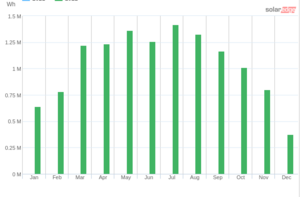
The ideal fixed tilt for your panels depends on your latitude,
and we have 10/12 roofs which are nearly ideal for our latitude.
The ideal azimuth is due south or 180 deg, and our roofs are at 170, so within 10 deg of optimum!
Our solar panel contractor SunBug estimated we'd get 12.1 MWh over a year,
but I declined the very detailed assessment;
I knew our site was pretty much optimum!
The year isn't over, but we're on track to generate about 12.8 MWh with the monthly
production shown in the graph.

The house across the street was torn down this year, and they are building a much larger house there. Sounds like it could block some sun, but no, they cut down a white pine in the back yard which gave us some winter sun blockage, so things should be slightly better this winter! I'm also planning on cutting down one small tree and one branch which caused some summer obstruction, so next year might be a little better.
If you look at the graph, you'll see that in December and January with the lowest sun angles and the shortest days, we generate around 600 kWh. In February and November, we generate around 800 kWH. March through September we are at around 1200 kWh with October at around 1000 kWh. Let's delve into some details which might be of interest to some!
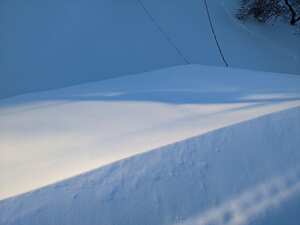 I can hear you saying, that's all well and good in the summer,
but what about the winter?
Actually, the 40 deg tilt of our panels is steep enough that on days that we get
2 or 3 inches of snow, they'll slide down the panels after an hour or two of sun,
so no action is required on my part.
If we get a lot more than that, then indeed something might be needed.
I can hear you saying, that's all well and good in the summer,
but what about the winter?
Actually, the 40 deg tilt of our panels is steep enough that on days that we get
2 or 3 inches of snow, they'll slide down the panels after an hour or two of sun,
so no action is required on my part.
If we get a lot more than that, then indeed something might be needed.
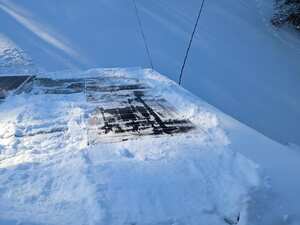 Some people use roof rakes to clear off their panels,
although they warn you not to do that because they might scratch the panels.
I use a big plastic push broom attached to the end of an extension pole.
It's long enough to clear off almost all of the garage panels from the ground
and the little bit at the top that I can't reach will melt pretty fast.
I need to do this before I get out the snow blower to clear the driveway!
The main house panels are higher, but I can use the same method to clear off
the lower ones.
Some people use roof rakes to clear off their panels,
although they warn you not to do that because they might scratch the panels.
I use a big plastic push broom attached to the end of an extension pole.
It's long enough to clear off almost all of the garage panels from the ground
and the little bit at the top that I can't reach will melt pretty fast.
I need to do this before I get out the snow blower to clear the driveway!
The main house panels are higher, but I can use the same method to clear off
the lower ones.
If we get a big snowfall and a great solar day is coming up, I will go up on my relatively flat dormer roof behind the panels and work from the roof down. I go up there anyway to shovel off very heavy snow to prevent ice dams where my rubber roof hits my regular roof, so it's not a big issue. Clearing off one pair of panels is pretty easy, but it's definitely some exercise to do them all after an 18" snowfall, say. The picture at left is of the snow on the roof on the morning of Jan 30. Eighteen minutes of vigorous exercise later the right picture shows the panels! The residual snow will melt in minutes when the sun hits it.
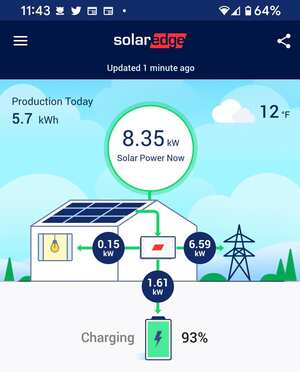 My system has a 7.6 kW SolarEdge inverter which is very efficient,
but unable to convert the full 10kW rated power of
my panels into AC for use by me or transmission to the power grid.
That brought two questions to my mind.
First, how often could my system be producing in excess of 7.6 kW?
And second, could any of
this surplus power charge my storage battery because it is on the DC side
of the inverter?
My system has a 7.6 kW SolarEdge inverter which is very efficient,
but unable to convert the full 10kW rated power of
my panels into AC for use by me or transmission to the power grid.
That brought two questions to my mind.
First, how often could my system be producing in excess of 7.6 kW?
And second, could any of
this surplus power charge my storage battery because it is on the DC side
of the inverter?
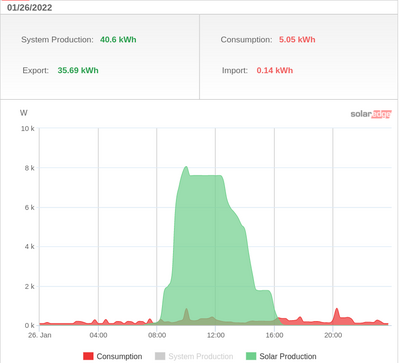
It didn't take long to find the answer to my second question. In the phone app screenshot you can see that my system was generating 8.35 kW at 11:43 on Jan 21. Only 6.74 of that was being converted to AC by the inverter; the rest was being used to charge my battery, proving that indeed the system could generate DC and AC simultaneously. The problem was that my battery was being charged rapidly, and indeed 52 minutes later it was fully charged. In the graph at right you see that on Jan 26 there is a brief burst of production beyond 7.6 kW after which the battery is fully charged so production drops to 7.6 kw (the flat line) and solar energy is lost. (The smaller flat area at around 15:00 is usually caused by the sun going down while some shadows exit the panels, the two effects canceling out.)
My battery is an LG RESU16H Prime with 16 kWh capacity, but it is completely controlled by the SolarEdge inverter as far as I can tell. There is supposed to be an app/website to at least observe the battery, but I never got it working. I asked my solar contractor SunBug if there was any way to restrict the battery to charge from clipped solar only, so as to retain capacity whenever there was such available surplus power, and was told that there was.
As delivered, my inverter was in "Maximize self consumption" mode 24/7, in which it tries to minimize the power sent or received over the power lines. Hence it would charge as soon as the sun was shining until it got to 100%, and then it would discharge at night as far as my usage would allow. Note that not all of our electrical system is on the battery backup. It would be crazy to put the car charger, electric stove, or electric dryer on the system since the battery is just not that big! The subpanel has about 2/3 of our electrical outlets, our internet, our refrigerator, our minisplit heat pump, our oil burner furnace, and our sump pump. Other things can be powered by using an extension cord, generally.
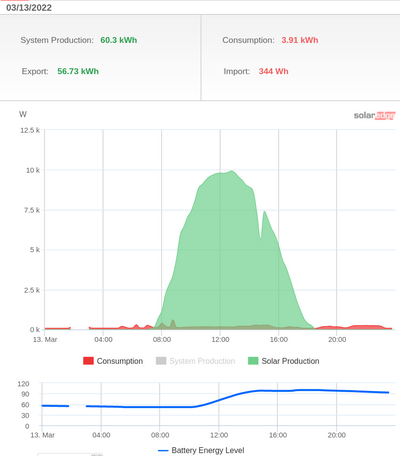 I got Sunbug to switch it over to "Charge from clipped solar power"
between the hours of 5am and 5pm.
It wasn't clear that the battery would ever discharge if it was in
this mode 24 hours a day!
The graph shows the first sunny day after this change was made.
The battery was charged from 51.6% to 97.4% from clipped solar.
It's a 16 kWh battery, but that doesn't mean that you actually can
charge and discharge it that much.
Interestingly enough my plug-in hybrid car also has a 16 kWh LG battery,
and when that was at 0%, I charged it to 100% at a charging station that told me
I used 12.5 kWh, which is probably a good guess for the home battery as well.
So we probably got around 6 kWh of free, clipped solar,
on a day when we generated 60.3 kWh total.
So we gained 10% due to our battery setup!
I got Sunbug to switch it over to "Charge from clipped solar power"
between the hours of 5am and 5pm.
It wasn't clear that the battery would ever discharge if it was in
this mode 24 hours a day!
The graph shows the first sunny day after this change was made.
The battery was charged from 51.6% to 97.4% from clipped solar.
It's a 16 kWh battery, but that doesn't mean that you actually can
charge and discharge it that much.
Interestingly enough my plug-in hybrid car also has a 16 kWh LG battery,
and when that was at 0%, I charged it to 100% at a charging station that told me
I used 12.5 kWh, which is probably a good guess for the home battery as well.
So we probably got around 6 kWh of free, clipped solar,
on a day when we generated 60.3 kWh total.
So we gained 10% due to our battery setup!
The other thing that needs to be adjusted is the "Backup Reserve" battery percentage which is always retained (except in a power outage, of course). That can be safely set to 25% to 30% in periods of large clipped solar, and raised to around 50% or even a little more in periods of small clipped solar. Obviously if this is too large, since we can't discharge below its value during the night, we might run out of capacity for clipped solar the next day. At the start of the year I had to get SunBug to adjust this as well, but SolarEdge fixed their app at some point so that now I can do it myself.
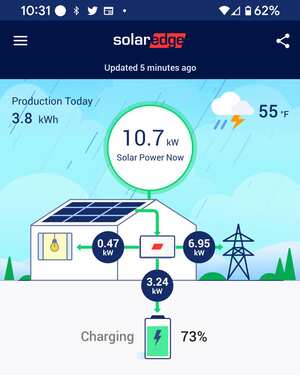 My solar panels are LG LG400Q1C-A6 panels putting out 400W, nominally.
It's interesting to me as an owner that after 25 years,
they are guaranteed to put out 92.5% of their original spec,
but it's of more interest to us here that they have a -0.29 % per deg C
temperature coefficient.
The nominal temperature of 44C is pretty high, but the ambient temperature
for that measurement was 20C or 68F.
So in hot weather things will be worse,
but in cold weather they will be quite a bit better.
We do get some of that around here in MA.
For instance, an ambient temperature of 0C or 32F which we frequently experience
would give us a boost of 5.8%, so maybe a 10,580 W system.
If the wind is blowing hard under the panels,
then the cooling effect might keep the panel temperature less than 24C above
the ambient temperature.
As the screenshot from Feb 18 shows, indeed my system can put out more than 10 kW.
But temperature is not the only factor that can affect maximum output!
My solar panels are LG LG400Q1C-A6 panels putting out 400W, nominally.
It's interesting to me as an owner that after 25 years,
they are guaranteed to put out 92.5% of their original spec,
but it's of more interest to us here that they have a -0.29 % per deg C
temperature coefficient.
The nominal temperature of 44C is pretty high, but the ambient temperature
for that measurement was 20C or 68F.
So in hot weather things will be worse,
but in cold weather they will be quite a bit better.
We do get some of that around here in MA.
For instance, an ambient temperature of 0C or 32F which we frequently experience
would give us a boost of 5.8%, so maybe a 10,580 W system.
If the wind is blowing hard under the panels,
then the cooling effect might keep the panel temperature less than 24C above
the ambient temperature.
As the screenshot from Feb 18 shows, indeed my system can put out more than 10 kW.
But temperature is not the only factor that can affect maximum output!
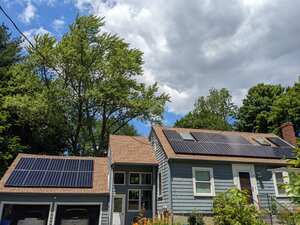 Clouds are obviously the bane of solar generation,
but interestingly enough, they can also increase solar generation when low dense
clouds such as in the picture (taken Jun 29)
reflect additional sunlight onto the panels
while being positioned so that they do not block the direct sunlight.
I have seen output from my system of 11.2 kW a few times due to this!
The SolarEdge software saves 15 minute snapshots of my system generation,
so it didn't capture this, and I didn't capture it with a screenshot from
the app, which is more instantaneous.
Clouds are obviously the bane of solar generation,
but interestingly enough, they can also increase solar generation when low dense
clouds such as in the picture (taken Jun 29)
reflect additional sunlight onto the panels
while being positioned so that they do not block the direct sunlight.
I have seen output from my system of 11.2 kW a few times due to this!
The SolarEdge software saves 15 minute snapshots of my system generation,
so it didn't capture this, and I didn't capture it with a screenshot from
the app, which is more instantaneous.
What about snow-covered terrain? Can you get more solar from reflected light from the ground? The answer is yes, and I have observed that. Anything that might require you to put on your sun glasses to view is putting out some significant amount of light.
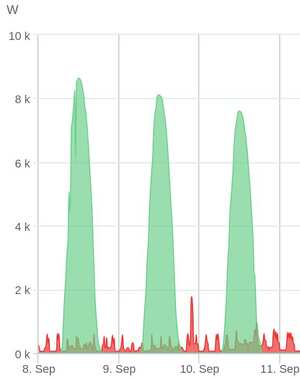 What about pollution?
Can it reduce the solar output?
The answer is yes. In September, forest fires from the west created smoke in
the upper atmosphere even in New England,
as was well reported in the media.
We could smell the smoke just going outside.
The graph shows that on two consecutive sunny days the output went down!
There's no cure for this but hoping that climate change doesn't kill us
with continuous forest fires.
What about pollution?
Can it reduce the solar output?
The answer is yes. In September, forest fires from the west created smoke in
the upper atmosphere even in New England,
as was well reported in the media.
We could smell the smoke just going outside.
The graph shows that on two consecutive sunny days the output went down!
There's no cure for this but hoping that climate change doesn't kill us
with continuous forest fires.
These transient effects make the battery even more valuable as a means of capturing extra energy. The inverter starts charging the battery within a few seconds of one of these surges beyond 7.6 kW. I've observed it charging at as high as 5 kW, which suggests that its capacity to absorb clipped solar extends to a system output of at least 12.6 kW. As the battery approaches full charge, however, the charge rate slows down so it's best to avoid that regime.
We've established in theory the battery can capture as much excess (clipped) solar as our system can reasonably put out, but that's only if we're also able to discharge that battery at some point so it's ready for the next sunny day! I put our main refrigator on the battery circuit, which has the dual advantages of surviving power outages and also discharging the battery a little. Whether or not we discharge the battery in the normal course of things depends on the time of year! In the summer our mini-split heat pump is certainly doing some A/C which nicely discharges it overnight. Similarly, in early spring and late fall, we are doing some heating with the mini-split and we are all set.
However, I found out that in late spring we are doing very little heating and cooling, but the clipped solar can be considerable! What about charging our car batteries, you suggest? Sounds like a plan, except that our level 2 car charger is too big of a load to be on the battery backup circuit. (If you click on the clouds picture above and look at the lower left part of the bigger version you can see our Kia Niro EV on the left and our plug-in hybrid Chrysler Pacifica on the right, with the little white box on the wall in between, which is our charger.)
So near, and yet so far, it seems! Well, actually we also have a couple of level 1 chargers which run from 120V and charge at about 1500W. Plugging in one of those instead enables us to move the power from the home battery to one of our car batteries and get free energy, as it were. Otherwise, our home battery would charge to 100% during the clipped solar time and drop the remaining power on the floor. We are inverting the DC to AC and then re-converting it back to DC, but we're fairly efficient in those steps. There only seemed to be about a month during which this trick was helpful. Obviously it's not costing us a lot if we're out of town and lose some clipped solar.
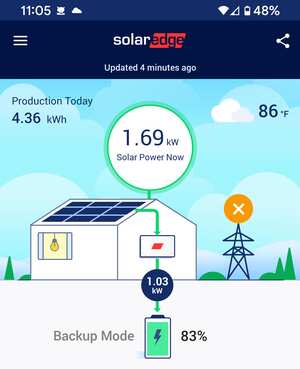 A power failure isn't something that most of us wish for,
but once my system was up and running, I was hoping to see one!
We had no power failures longer than a few seconds until July 25,
when Eversource had to replace a transformer and we had a planned outage
of a couple of hours.
The system worked like a charm.
As you can see from the small weather portion of the screenshot,
it was a warm but cloudy day.
The system went into "Backup Mode" in which all of the solar power not used
by the home went into the battery.
Obviously on a cloudy day like this we wouldn't be obtaining any clipped solar,
but at the time shown, near the end of the outage, we were generating 1690W
from the panels, and using about 670W to run our mini-split air conditioner
and other miscellaneous household appliances.
Our battery went from 70% charged to 85% or so during the outage,
which suggests that in an extended power outage,
even given a few cloudy days in a row, we'd probably
be sitting pretty fat and happy power wise.
A power failure isn't something that most of us wish for,
but once my system was up and running, I was hoping to see one!
We had no power failures longer than a few seconds until July 25,
when Eversource had to replace a transformer and we had a planned outage
of a couple of hours.
The system worked like a charm.
As you can see from the small weather portion of the screenshot,
it was a warm but cloudy day.
The system went into "Backup Mode" in which all of the solar power not used
by the home went into the battery.
Obviously on a cloudy day like this we wouldn't be obtaining any clipped solar,
but at the time shown, near the end of the outage, we were generating 1690W
from the panels, and using about 670W to run our mini-split air conditioner
and other miscellaneous household appliances.
Our battery went from 70% charged to 85% or so during the outage,
which suggests that in an extended power outage,
even given a few cloudy days in a row, we'd probably
be sitting pretty fat and happy power wise.
Rumor had it that the system might be able to turn on in milliseconds, but that didn't happen. It took some number of integer seconds, so our digital clocks needed resetting, but certainly it was not a long delay. Also a lot quieter than firing up a generator somewhere!
I'm keeping this page primarily to technical issues, but I am enrolled in the Eversource program which uses my battery during the summer for grid storage during very hot days. Unfortunately, I didn't get correctly registered for this thing until the summer season was about over. There was possibly some issue with SunBug getting me registered at the beginning, and contacting SolarEdge and Eversource was pretty much a nightmare. I started it in June, and both of those organizations replied to my emails in almost exactly one month. Once I got someone, I could go back and forth with them a little, but SolarEdge's software wasn't able to tell the tech support person whether or not I was actually enrolled in ConnectedSolutions. They kept telling me that my system was working fine, a reassurance that I certainly did not need.
We eventually got it straightened out. Maybe I'll write a financial page next year describing the money flow. No, I'm not paying electric bills despite two electric cars, and I get monthly checks.
Even though I own the system free and clear, I do not have access to the full configuration application. I tried to get that, but failed after some issues with their software which really reflects issues with their policy. We have had a surge of "Right to repair" laws recently but I actually need a "Right to Operate" law to straighten this out. SunBug is quite responsive and will typically make changes that I request within a few days, but there should be no reason at all to bug them (pun intended). I do recommend them, but there are only a few people I know who might be installing solar.
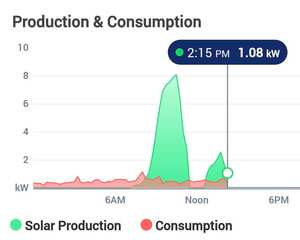 The SolarEdge inverter has been quite reliable, and the only failure I observed
took place after about 11 months of operation.
On a sunny day it suddenly output nothing, as you can see from the graph.
After I randomly checked my app and noticed the problem,
I rebooted the system according to the instructions which I got initially
and which can be found on the internet.
(Switch off the inverter, wait five minutes for a few capacitors to discharge,
and then switch off the DC from the panels with the switch near the inverter.
Next disconnect the whole solar system using the outside switch near the
electric meter, wait 30 seconds, and then switch it on and reverse the other
two steps.)
It worked like a charm--perhaps a cosmic ray hit the memory,
or an obscure software bug got triggered somehow.
The SolarEdge inverter has been quite reliable, and the only failure I observed
took place after about 11 months of operation.
On a sunny day it suddenly output nothing, as you can see from the graph.
After I randomly checked my app and noticed the problem,
I rebooted the system according to the instructions which I got initially
and which can be found on the internet.
(Switch off the inverter, wait five minutes for a few capacitors to discharge,
and then switch off the DC from the panels with the switch near the inverter.
Next disconnect the whole solar system using the outside switch near the
electric meter, wait 30 seconds, and then switch it on and reverse the other
two steps.)
It worked like a charm--perhaps a cosmic ray hit the memory,
or an obscure software bug got triggered somehow.
I got a complaining email after this telling me that some unauthorized person had been tampering with my inverter, and that if I had any issues I should call them. This is from the company which has my email, yet did not notify me that my inverter had malfunctioned, which should have been obvious to them. The possibility of a giant alien spaceship suddenly hovering over my house and blocking all possible light to the panels is too remote. It's also the company that responds in about 30 days to my (admittedly non-emergency) emails.
The next day I got another complaining email summarizing the events of the day before and saying basically the same thing. Pretty hilarious, SolarEdge. No, I won't be contacting you in the future unless it's a true emergency. A transient event that vanishes on rebooting does not qualify.
I haven't touched on battery life, but the way I operate my battery tends to keep it between 20% and 80% charge, which probably increases its life. Also, charging from clipped solar only limits the charge rates, as does discharging it to my local electrical loads; both should also help with battery life.